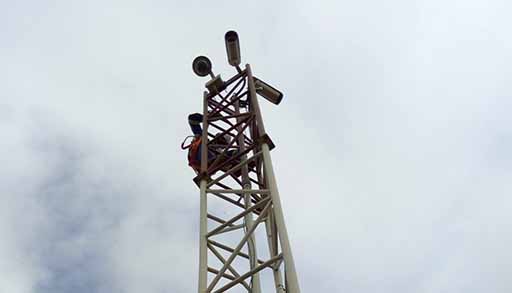CCTV CAMERAS
Emergency Call - 24/7
- +233 20 586 4334


Meeting today’s video surveillance challenges
The video surveillance market is booming, driven by increased public and private security concerns, as well as a technology shift. The transition to network video is a reality as customers take advantage of flexible, industry standard systems for security and video surveillance. As security management over the IP network expands and intelligence capabilities move out to network cameras, systems can scale much more easily. This move to open systems empowers a much more productive and cost-effective means of surveillance than was ever possible
For the security manager, the shift to network video creates new opportunities where digital technology can be put to use to deliver maximum value.
The IP Way
How it works
Protecting existing CCTV investments
Significant investments in analog CCTV systems may have already been made. The technology shift to network video does not, however, mean that existing analog CCTV investments have to be discarded. With a network video solution, you can integrate your existing analog system into an IP-based solution. The solution enables you to take advantage of numerous functionalities such as remote pan/tilt/zoom, Power over Ethernet, audio, video motion detection, while meeting user requirements for image quality, recording capabilities, reliability, and cost-effectiveness.
Existing CCTV investments
Significant investments in analog CCTV systems may have already been made. The technology shift to network video does not, however, mean that existing analog CCTV investments have to be discarded. With a network video solution, you can integrate your existing analog system into an IP-based solution. The solution enables you to take advantage of numerous functionalities such as remote pan/tilt/zoom, Power over Ethernet, audio, video motion detection, while meeting user requirements for image quality, recording capabilities, reliability, and cost-effectiveness.
Video encoders make it possible to move toward a network video system without having to discard existing analog equipment. They connect to analog cameras, digitize the images and send them over an IP network, allowing analog cameras to take advantage of many of the same benefits as provided by network cameras.
Network cameras
Connecting directly to the IP network, they capture and send live video directly over the IP network.
Video management and storage
A standard PC with video management software can be used to monitor and record the video.
Remote access
Any camera can be monitored remotely from anywhere on the LAN or the Internet.
Video decoder
If network video streams need to be monitored on existing analog equipment, an Axis video decoder can be used.
encoders make it possible to move toward a network video system without having to discard existing analog equipment. They connect to analog cameras, digitize the images and send them over an IP network, allowing analog cameras to take advantage of many of the same benefits as provided by network cameras.


Superior image quality
Image quality is clearly one of the most important features of any camera, if not the most important. Superior image quality enables the user to more closely follow details and changes in images, making for better and faster decisions to more effectively safeguard people and property. It also ensures greater accuracy for automated analysis and alarm tools. Network cameras provide high-quality video images, and megapixel and HDTV network cameras are available to provide even more image details.
Scalability and flexibility
A network video system can be expanded by adding more network cameras. You can choose exactly what you need today, and scale the system at any time to meet your growing needs. New technologies, additional cameras, and extra storage capacity can all be easily added as required, thanks to strict adherence to industry standards.
Easy, future-proof integration
There are almost no limitations as to where a network video product can be placed. Network video has the capacity to provide a high level of integration with other equipment and functions, making it a continually developing system. A fully integrated network video system can be used for a multitude of applications simultaneously: for instance, access control, building management, point-of-sales systems, ATMs, as well as fire, intruder and visitor management.
Distributed intelligence
These days, a massive amount video is being recorded, but never watched or reviewed due to lack of time. As a result, events and activities are missed, and suspicious behaviors remain unnoticed. With network video, intelligence has been brought into the camera itself. Network cameras can have built-in video motion detection and alarm management so the camera decides when to send video, at what frame rate and resolution, and when to alert a specific operator. Other unique features include audio detection and active tampering alarm.
Lower total cost of ownership
The majority of businesses now have high-speed, IP-based networks connected to the Internet. Adding a network video system simply utilizes and extends the same infrastructure to include video functionality. Standard IT equipment such as switches, PC servers for video recording and storage, are used, so existing investments in IT infrastructure and devices can be leveraged, ensuring high return on investment.
A more secure system
Network video offers more ways to secure access to video than can be provided by an analog CCTV system. Passwords can be used to limit access, and video can be encrypted before being sent over the network to make sure it cannot be viewed or tampered with. The system can also be set up to authenticate the connection using encrypted certificates that only accept a specific network video device, thus eliminating the possibility of anyone hacking into the system.
Easy and cost-effective expansion
A network video system is extremely flexible. Cameras can be moved freely around the network, and the system can be expanded by adding more network cameras. This is easily done regardless of whether the new cameras are to be placed at the same site, or at a new location communicating over the Internet.
Remote accessibility
With network video, users can access real-time video at any time from any authorized computer anywhere. Network video products provide an easy way to capture and distribute high quality video over any kind of IP network or the Internet. The video can be stored at remote locations for convenience and security, and the information can be transported over the LAN or Internet.
Cost-effectiveness
Based on open standards, Axis network video products run on IP networks. Using standard PC server hardware rather than proprietary equipment such as DVRs radically reduces management and equipment costs, particularly for larger systems where storage and servers are a significant portion of the total solution cost. Additional cost savings come from the infrastructure used. IP-based networks such as LANs and the Internet can be leveraged for other applications across the organization.
Easy, future-proof integration
There are almost no limitations as to where a network video product can be placed. Network video has the capacity to provide a high level of integration with other equipment and functions, making it a continually developing system. A fully integrated network video system can be used for a multitude of applications simultaneously: for instance, access control, building management, point-of-sales systems, ATMs, as well as fire, intruder and visitor management.
Distributed intelligence
These days, a massive amount video is being recorded, but never watched or reviewed due to lack of time. As a result, events and activities are missed, and suspicious behaviors remain unnoticed. With network video, intelligence has been brought into the camera itself. Network cameras can have built-in video motion detection and alarm management so the camera decides when to send video, at what frame rate and resolution, and when to alert a specific operator. Other unique features include audio detection and active tampering alarm.
Lower total cost of ownership
The majority of businesses now have high-speed, IP-based networks connected to the Internet. Adding a network video system simply utilizes and extends the same infrastructure to include video functionality. Standard IT equipment such as switches, PC servers for video recording and storage, are used, so existing investments in IT infrastructure and devices can be leveraged, ensuring high return on investment.
A more secure system
Network video offers more ways to secure access to video than can be provided by an analog CCTV system. Passwords can be used to limit access, and video can be encrypted before being sent over the network to make sure it cannot be viewed or tampered with. The system can also be set up to authenticate the connection using encrypted certificates that only accept a specific network video device, thus eliminating the possibility of anyone hacking into the system.
Easy and cost-effective expansion
A network video system is extremely flexible. Cameras can be moved freely around the network, and the system can be expanded by adding more network cameras. This is easily done regardless of whether the new cameras are to be placed at the same site, or at a new location communicating over the Internet.
Remote accessibility
With network video, users can access real-time video at any time from any authorized computer anywhere. Network video products provide an easy way to capture and distribute high quality video over any kind of IP network or the Internet. The video can be stored at remote locations for convenience and security, and the information can be transported over the LAN or Internet.
Cost-effectiveness
Based on open standards, Axis network video products run on IP networks. Using standard PC server hardware rather than proprietary equipment such as DVRs radically reduces management and equipment costs, particularly for larger systems where storage and servers are a significant portion of the total solution cost. Additional cost savings come from the infrastructure used. IP-based networks such as LANs and the Internet can be leveraged for other applications across the organization.
